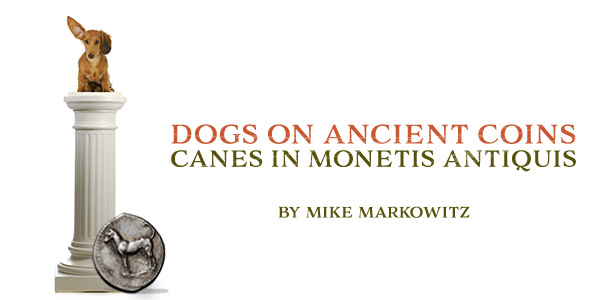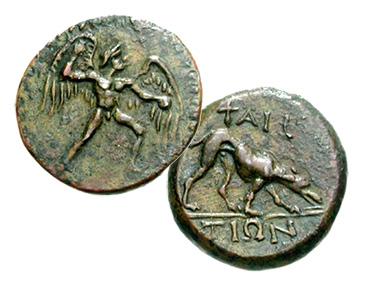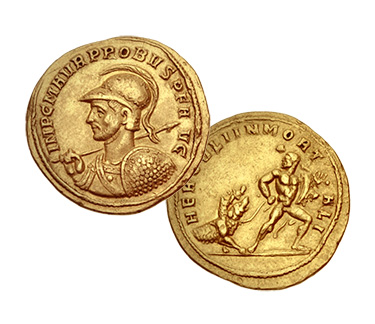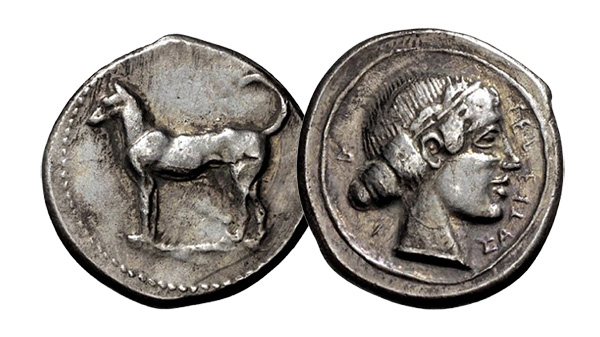
CoinWeek Ancient Coin Series by Mike Markowitz …..
You ain’t nothing but a hound dog, crying all the time.
You ain’t nothing but a hound dog, crying all the time.
You ain’t never caught a rabbit, and you ain’t no friend of mine.—Elvis Presley, 20th-century American philosopher, covering Big Mama Thornton’s “Hound Dog” in 1956
DOGS AND PEOPLE have been companions for at least 15 thousand years. Some DNA evidence suggests that this date might be pushed back as much as 40 thousand years ago[1]. Dogs and wolves are closely related, and in the earliest images created by Stone Age artists, it is not always clear whether we are seeing a dog or a wolf. In ancient Egyptian art, we occasionally see working dogs used in hunting and war. Images of the dog, both realistic and fanciful, begin to appear on coins soon after dawn of coinage in the sixth century BCE.
Cyzicus
The Greek city of Cyzicus, located on the Sea of Marmara, prospered for centuries on the trade in dried tuna, thanks to the seasonal migration of great schools of these fish between the Black Sea and the Aegean[2]. The fish appears as a distinctive emblem on the city’s coinage, along with a bewildering variety of other images. Numismatists believe that the design of the coinage changed every year, and the symbols may be the personal seals of magistrates elected annually. Struck in electrum, a variable alloy of gold and silver, the 16-gram “Cyzicene” stater and its fractions (a third and a sixth) circulated widely in the Greek world.
Possibly the earliest appearance of any canine on a coin is the winged dog on a stater of Cyzicus dated to c. 550 – 450 BCE[3]. Flying dogs seem to have gone extinct in antiquity, much to the relief of the birds[4].
Another fanciful image on a Cyzicene stater (c. 500-450 BCE) is Cerberus (or Kerberos) the mythical three-headed hound that guarded the entrance to the underworld. On the coin[5], only two heads are visible. A perfectly ordinary dog (although beautifully rendered) appears along with the emblematic tuna on another stater of roughly the same date[6].
Segesta and Eryx
A mysterious people called the Elymians settled in western Sicily around the 11th century BCE[7]. The Greeks imagined that the Eymians were refugees from the Trojan War. Their language has never been deciphered; only a few fragmentary inscriptions in Greek letters survive. The city of Segesta was their capital. They adopted Greek culture and customs, although they were often under Carthaginian rule. A magnificent unfinished Doric-style temple and a Greek theater carved into a hillside still survive on the site. Segestan coinage in silver[8] and bronze[9] begins in the fifth century BCE, and it invariably bears an image of a hunting dog that closely resembles the modern Sicilian hound: a slim, long-legged beast with pointed ears and a curled tail. The Sicilian hound closely resembles the “Pharaoh hound” of ancient Egypt[10].
The nearby hilltop town of Eryx (now Erice) was an important shrine of a fertility goddess, identified with Aphrodite by the Greeks. Today it is famous for its delicious sweets and pastries. Like Segesta, Eryx used a dog as its emblem on silver[11] and bronze[12] coins, which are fairly rare.
Phaistos
 Phaistos, on the island of Crete, issued rare coins depicting Talos, a mythical giant (some say robot) made out of bronze by the god Hephaistos in order to protect the island. The companion of Talos was Laelaps[13], a magical golden hound, who was eventually placed in the sky as the constellation Canis Major. Talos and Laelaps appear on a bronze coin of Phaistos dated to c. 300-250 BCE[14].
Phaistos, on the island of Crete, issued rare coins depicting Talos, a mythical giant (some say robot) made out of bronze by the god Hephaistos in order to protect the island. The companion of Talos was Laelaps[13], a magical golden hound, who was eventually placed in the sky as the constellation Canis Major. Talos and Laelaps appear on a bronze coin of Phaistos dated to c. 300-250 BCE[14].
Pherai
One of the most striking dog images on an ancient coin appears on a tiny (11 mm, 0.83 gram) and very rare silver obol of Pherai, in the Thessaly region of northern Greece, dated to the fourth century BCE[15]. The reverse bears the sensitive and artfully modeled head of a sheep dog, possibly the massive “Molossian”[16], similar to the modern Balkan sheepdog.
Mamertines
The Mamertines, or Mamertinoi (“sons of Mars”), were an army of unemployed Greek mercenaries who went rogue and seized the town of Messana, Sicily in 288 BCE, killing the men and taking the women as their wives. They ruled the region around Messana for decades, issuing coins in their own name. The reverse of a large bronze, dated to c. 278-264, bears a superbly modeled image of a standing dog of uncertain breed[17].
The Romans
The reverse of a Roman Republican denarius[18] of 82 BCE recounts one of the best-loved stories of canine loyalty in ancient literature. Returning home incognito, after 20 years absence, the Greek hero Odysseus (Ulysses to the Romans) is recognized only by his elderly dog, Argos:
‘This dog,’ answered Eumaios, ‘belonged to him who has died in a far country. If he were what he was when Odysseus left for Troy, he would soon show you what he could do. There was not a wild beast in the forest that could get away from him when he was once on its tracks. But now he has fallen on evil times, for his master is dead and gone, and the women take no care of him. Servants never do their work when their master’s hand is no longer over them, for Zeus takes half the goodness out of a man when he makes a slave of him.’[19]
So saying he entered the well-built mansion, and made straight for the riotous pretenders in the hall. But Argos passed into the darkness of death, now that he had fulfilled his destiny of faith and seen his master once more after 20 years.
The goddess Diana (Artemis to the Greeks), as the patroness of hunting, is usually accompanied by one or more dogs in ancient art, including images on coins. A fairly common example is the denarius of C. Postumius dated to 73 BCE[20]. The obverse bears a bust of Diana with a bow over her shoulder. On the reverse, we see a running hound.
 On the reverse of a provincial bronze of Commodus (177-192 CE) from Cyzicus[21], we see Artemis hunting with her hound.
On the reverse of a provincial bronze of Commodus (177-192 CE) from Cyzicus[21], we see Artemis hunting with her hound.
One of the last examples of a dog on a Roman imperial coin is a rare gold aureus of Emperor Probus dated to 278 CE[22]. The spectacular reverse shows the final labor of Hercules, who was required to enter the underworld to capture and bring back the three-headed dog Cerberus. This is one of the few coin images of Cerberus to clearly show all three heads, ferociously snapping at the hero.
Collecting Dogs on Coins
On the CoinArchives Pro database, which records some two million pieces that have appeared in major auctions since approximately 1999, a casual search for “dog or hound” turns up almost 2,400 hits. Most of these, however, are coins where the dog appears as a tiny stick figure alongside some deity, such as Artemis or the syncretic god Serapis. Examples where the canine is the major design element are surprisingly uncommon, considering the important role that working dogs played in the lives of ancient Greeks and Romans. Assembling a collection of the best dog images on ancient coins would be a challenge even for a collector with great patience, persistence and deep pockets.
* * *
Notes
[1] For a review of the genetic evidence, see: https://en.wikipedia.org/wiki/Origin_of_the_domestic_dog
[2] Often described as a “tunny fish” the little tunny (Euthynnus alletteratus) still swims the Mediterranean, although overfishing has depleted its numbers.
[3] CNG Triton XX, 10 January 2007. Lot 204; realized $6,000 USD.
[4] Greek artists added wings to their depictions of living things to endow them with supernatural power. Pegasus, the flying horse, and Nike, the goddess of victory, are common examples. Some early coins even bear a winged boar.
[5] Roma Numismatics Auction XII, 29 September 2016. Lot 289; realized $23,368
[6] Roma Numismatics Auction XII, 29 September 2016. Lot296; realized $7,789
[7] https://en.wikipedia.org/wiki/Elymians
[8] Gerhard Hirsch Nachfolger Auction 296, 13 February 2014. Lot 1571; realized $3,143
[9] Gorny & Mosch Auction 211, 4 March 2013. Lot 73. Unsold (estimate 1,200 euros)
[10] https://en.wikipedia.org/wiki/Pharaoh_Hound
[11] Gorny & Mosch Auction 215, 13 October 2015. Lot 681; realized $1763
[12] Bertolami Fine Arts Auction 6, 10 December 2012. Lot 191; realized $504
[13] https://www.greekmythology.com/Myths/Creatures/Laelaps/laelaps.html
[14] CNG Triton XI, 8 January 2008. Lot 195; realized $4,000
[15] CNG Triton XV, 3 January 2012 Lot 693; realized $9,500
[16] https://en.wikipedia.org/wiki/Molossus_(dog)
[17] Gorny & Mosch Auction 159, 8 October 2007. Lot 37; realized $914
[18] Hess-Divo Auction 314, 4 May 2009. Lot 1352; realized $484
[19] Homer. Odyssey, Book 17, lines 290-327
[20] CNG Electronic Auction 390, 1 February 2017. Lot 545; realized $90
[21] Gorny & Mosch Auction 181, 12 October 2009. Lot 1759; realized $148
[22] CNG Mail Bid Sale 84, 5 May 2010. Lot 1390; realized $22,000
References
Coppingter, Raymond. Dogs. New York (2001)
Derr, Mark. How the Dog Became the Dog. New York (2011)
Jones, John Melville. A Dictionary of Ancient Greek Coins. London (1986)
Sear, David. Greek Coins and Their Values. Vol. I, Europe (1978)
–. Greek Coins and Their Values. Vol. II, Asia & Africa (1979)
NGC-Certified Ancient Greek Silver Coins Currently Available on eBay
[wpebayads]





